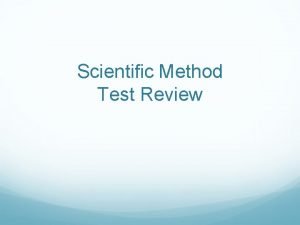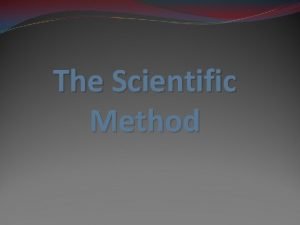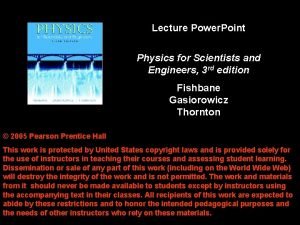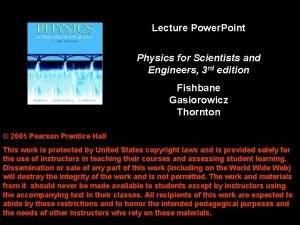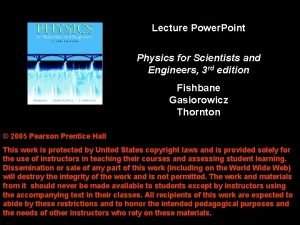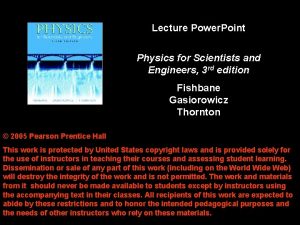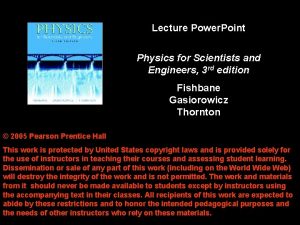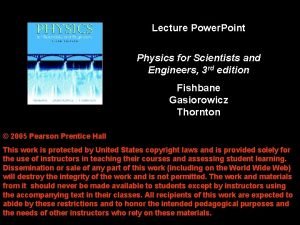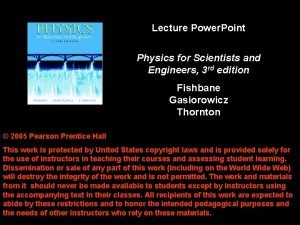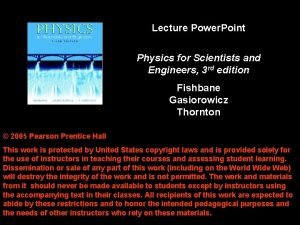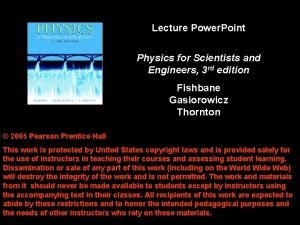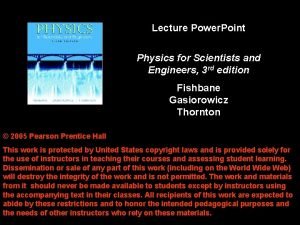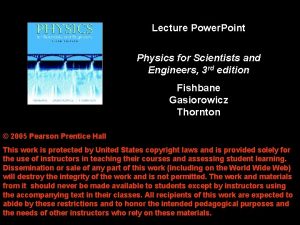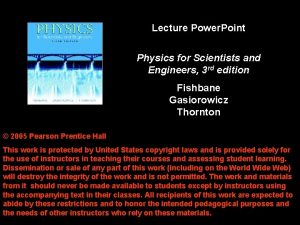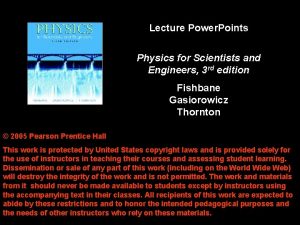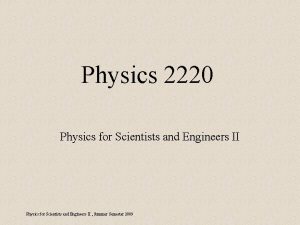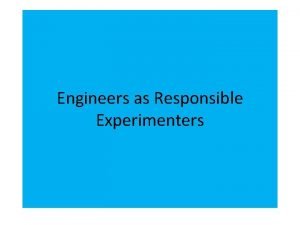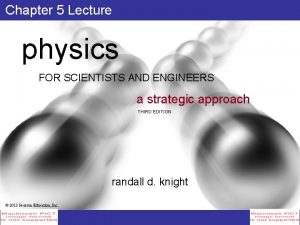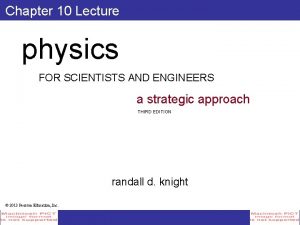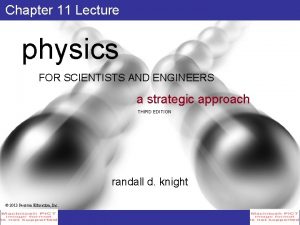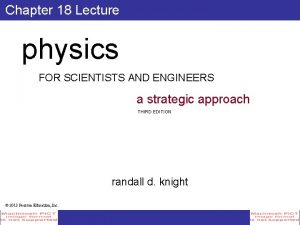Lecture Power Point Physics for Scientists and Engineers
























- Slides: 24

Lecture Power. Point Physics for Scientists and Engineers, 3 rd edition Fishbane Gasiorowicz Thornton © 2005 Pearson Prentice Hall This work is protected by United States copyright laws and is provided solely for the use of instructors in teaching their courses and assessing student learning. Dissemination or sale of any part of this work (including on the World Wide Web) will destroy the integrity of the work and is not permitted. The work and materials from it should never be made available to students except by instructors using the accompanying text in their classes. All recipients of this work are expected to abide by these restrictions and to honor the intended pedagogical purposes and the needs of other instructors who rely on these materials.

Chapter 29 The Production and Properties of Magnetic Fields

29 -1 Ampère’s Law • Experimental observation: two parallel current-carrying wires exert forces on each other • Assumption: current creates a magnetic field • Field can be mapped out • Field makes circles around wire, direction given by right-hand rule

29 -1 Ampère’s Law Field around a current-carrying wire:

29 -1 Ampère’s Law We find that: (29 -2) where (29 -3) In choosing a value for µ 0, the magnitude of the coulomb has been determined. This is the way the coulomb is defined.

29 -1 Ampère’s Law In addition, we have the magnetic field of a long straight wire: (29 -5) We can do a line integral around the wire, following the magnetic field lines: (29 -7)

29 -1 Ampère’s Law In this case, there is a current through the surface whose edge is defined by the path. Ampère’s Law is the generalization of this, valid for any current and path: (29 -10)

29 -1 Ampère’s Law Using Ampère’s Law to Find the Magnetic Field This can be done, but only in cases with a high degree of symmetry, such as a currentcarrying wire

29 -2 Gauss’ Law for Magnetism • No magnetic monopoles (single magnetic charge) have ever been observed • Magnetic field lines must be continuous • The magnetic “charge” inside any closed surface must always be zero.

29 -2 Gauss’ Law for Magnetism • Definition of magnetic flux: (29 -11) • Therefore, for any closed surface: (29 -12) This is Gauss’ law for magnetism.

29 -2 Gauss’ Law for Magnetism Field lines for a bar magnet: • Similar to those for a magnetic dipole • But no magnetic charges, so all field lines are closed loops

29 -3 Solenoids • A solenoid is a length of wire coiled into a cylinder • It produces a nearly uniform magnetic field within the cylinder parallel to its axis • The magnetic field outside the solenoid is very small

29 -3 Solenoids Using Ampère’s law to find the magnetic field in a solenoid: The dot product of B and ds is zero everywhere except along leg 4, where it is

29 -3 Solenoids This gives for the magnetic field: (29 -15) Here, n is the number of turns per unit length.

29 -3 Solenoids A toroidal solenoid • No end effects, as the ends are connected • But field is not constant across section of torus

29 -3 Solenoids A toroidal solenoid However, if radius of cross section r 0 is small compared to radius of torus R, magnetic field can be assumed to be constant.

29 -4 The Biot–Savart Law • Want to be able to calculate magnetic fields of current distributions that can’t be done with Ampère’s law • Can use the magnetic field of a straight section of wire; this gives the Biot–Savart law: (29 -19)

29 -4 The Biot–Savart Law Magnetic Dipoles • Magnetic field of a current loop is that of a magnetic dipole • Dipole strength is characterized by dipole moment µ • For a circular current loop: (29 -25) • For a loop of any shape: (29 -27)

29 -5 The Maxwell Displacement Current • Ampère’s law has a flaw when currents are varying • One closed line can be the edge of an infinite number of surfaces • As long as currents through all surfaces are the same, no problem • But if current is varying this may not be true

29 -5 The Maxwell Displacement Current For example, a capacitor charging up: Surface 1 has a current going through it but Surface 2 does not But: electric flux is changing through Surface 2

29 -5 The Maxwell Displacement Current • This can be fixed by adding a term called the displacement current • Displacement current is zero unless there is a changing electric field (29 -30) Generalized form of Ampère’s law: (29 -31)

Summary of Chapter 29 Magnetic field of a long straight wire carrying current I: (29 -5) Ampère’s law: (29 -10) Gauss’ law for magnetism: (29 -12)

Summary of Chapter 29, cont. Magnetic field of a solenoid: (29 -15) Biot–Savart law: (29 -19) Current loops form magnetic dipoles with magnetic moment µ: (29 -27)

Summary of Chapter 29, cont. If currents are not constant, Ampère’s law needs modification: (29 -31)
 01:640:244 lecture notes - lecture 15: plat, idah, farad
01:640:244 lecture notes - lecture 15: plat, idah, farad Power triangle formula
Power triangle formula Power bi power point
Power bi power point Point point power
Point point power Power system dynamics and stability lecture notes
Power system dynamics and stability lecture notes Power system dynamics and stability lecture notes
Power system dynamics and stability lecture notes Physics 111 lecture notes
Physics 111 lecture notes Physics 101 lecture
Physics 101 lecture Phy101 lecture 1
Phy101 lecture 1 Physics 101 lecture notes pdf
Physics 101 lecture notes pdf Physics waves notes pdf
Physics waves notes pdf Atmospheric physics lecture notes
Atmospheric physics lecture notes Zline 667-36
Zline 667-36 Power semiconductor devices lecture notes
Power semiconductor devices lecture notes Switch mode power supply lecture notes
Switch mode power supply lecture notes Things fall apart customs
Things fall apart customs Hub and spoke transportation
Hub and spoke transportation Sometimes scientists make a mistake or
Sometimes scientists make a mistake or Diagrams tables and graphs are used by scientists mainly to
Diagrams tables and graphs are used by scientists mainly to Why does it happen
Why does it happen University physics with modern physics fifteenth edition
University physics with modern physics fifteenth edition Good physics ia topics
Good physics ia topics Kontinuitetshantering
Kontinuitetshantering Novell typiska drag
Novell typiska drag Nationell inriktning för artificiell intelligens
Nationell inriktning för artificiell intelligens

















